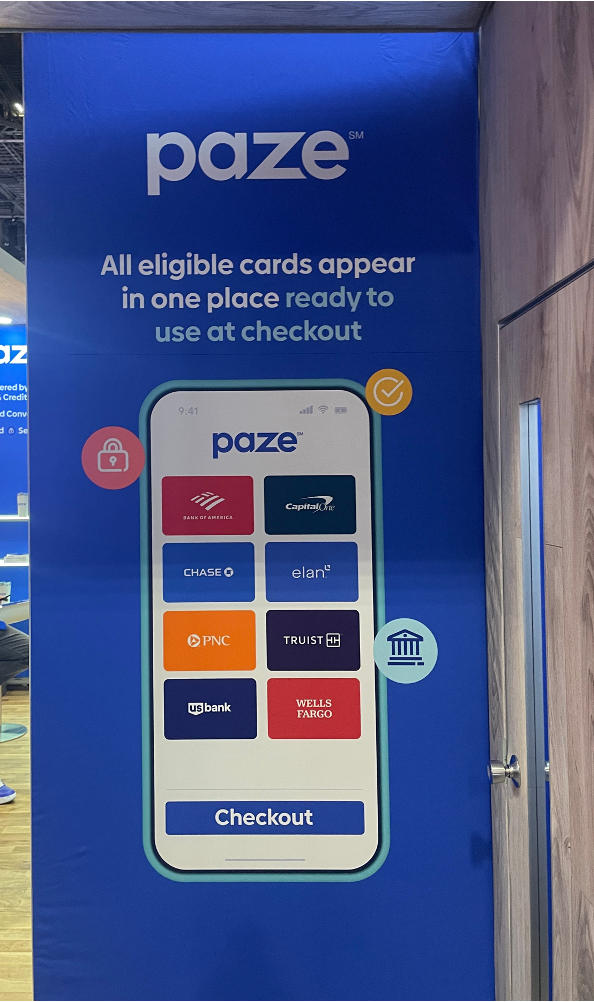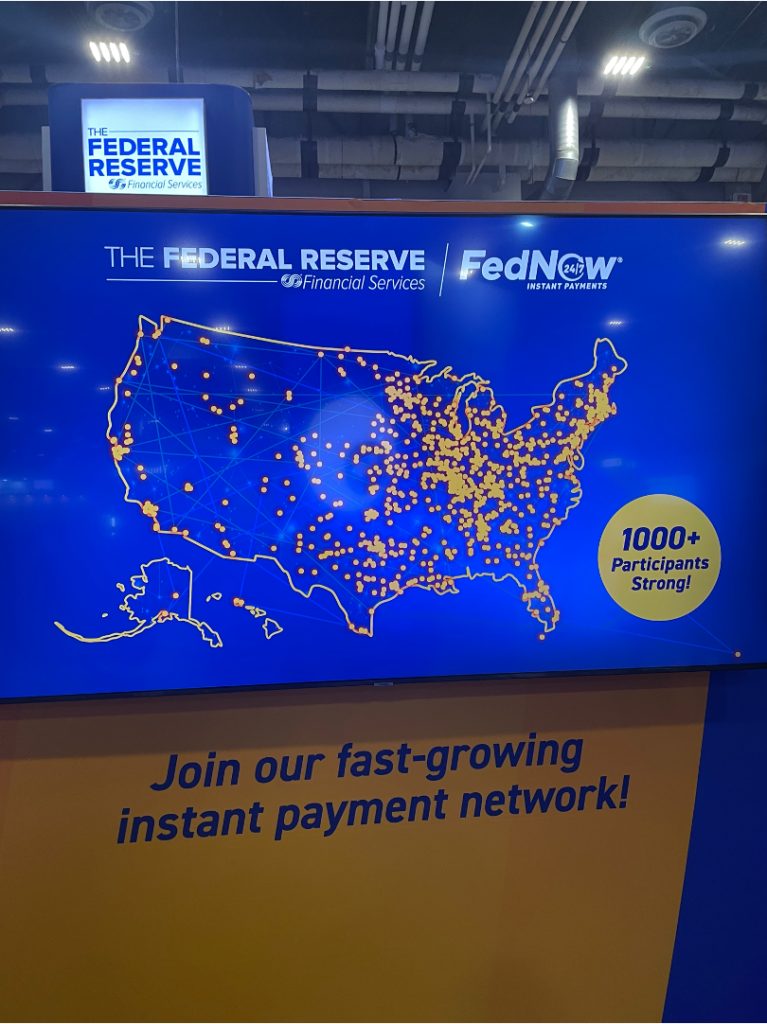65,000 steps.
20 in-person meetings.
4 live podcast recordings.
3 Off-the-record group dinners.
2 speaking sessions (both on open banking).
1 3×3 basketball tournament.
It was a very busy and productive Money20/20, and it wouldn’t have been possible without the help of Navan, Marqeta, FIS, Prism Data, MX, Sardine, LoanPro, Visa, and, of course, my colleagues at Workweek.
My brain is far too tired and too full to give you any kind of coherent analysis. However, I do have a scattered collection of photographs and notes to share, which hopefully will be useful!
Standard Setting Only Works When Everyone Has The Same Goal
On Sunday night, I had the distinct pleasure of interviewing Rohit Chopra, Director of the CFPB, on stage at Money20/20.

It was a wide-ranging conversation, and Director Chopra was very candid. I appreciated this (as did the audience) because a lot happened last week, including a group of big banks (represented by the Bank Policy Institute) suing the CFPB to stop its Personal Financial Data Rights Rule (AKA open banking).
When I asked him for his reaction to the 60-page lawsuit, which was filed hours after the CFPB released the 600-page final rule, Director Chopra said, “I haven’t read their lawsuit, and I don’t think they read the rule.”
That line got a big laugh from the audience.
Director Chopra went on to express concern that many of the same banks that had been working with fintech companies, data aggregators, and consumer groups to set standards for consumer-permissioned data access (through the Financial Data Exchange, which has applied to become an officially designated standard-setting organization under the rule) are now suing to stop the rule from being implemented.
I can tell you, after talking to many of the other folks involved in FDX, that concern is widely shared.
The big data aggregators and fintech companies focused on open banking were shocked and angered by the lawsuit, which happened less than a month after FDX announced that it was appointing Kevin Feltes (an FDX board member and former Head of Partnerships and Strategy for the Connected Banking at JPMorgan Chase) as its first CEO.
I understand their feelings.
Big banks can’t have it both ways.
If you believe that open banking is a threat to the safety of consumers’ financial data, you can’t also be working to enable pay-by-bank via open banking, as JPMorgan Chase (which has been relentlessly hammering the Personal Financial Data Rights Rule since it was released) is doing.
JPMorgan Chase and other big banks like PNC have the scale and technical aptitude to take advantage of the benefits of open banking. Trying to deny those benefits to other, smaller banks (and fintech companies) is blatantly anti-competitive.
And it makes creating industry standards and private network rules to govern how open banking will work (technically, operationally, and legally) much more difficult.
The Threat of Competition is What Matters
In a follow-up on-the-record conversation with reporters after our session, Director Chopra was asked how he would assess the success of the final rule in stimulating market competition, given that open banking hasn’t necessarily led to more account switching in other geographies like the U.K. Here’s what he said:
We have never seen as a success factor actual switching velocity. In some ways, we’re gonna want to look at deposit account competition factors. What are APYs? How is customer service looking? Are we going to see more banks give funds availability days before a paycheck or direct deposit? Some of this will just occur if banks and fintechs perceive that their customers can leave.
This is a really interesting and nuanced point, and it’s based on the Director’s observations of the effect that phone number portability has had on competition among landline and wireless carriers over the last 20 years.
I’m not sure that analogy (banks = telco carriers) is perfectly accurate. Depending on the product in question, I think it’s probably more accurate to compare the role that banks play in their customers’ lives to the role that the mobile device and OS providers (Google and Apple) play.
Still, it’s a useful way of thinking about the impact that the Personal Financial Data Rights Rule will have on the market.
Who Wins the Race?
Cash flow underwriting is another big use case for open banking. And Director Chopra spent a decent amount of time in our Q&A talking about his desire for the open banking rule to create more competition for FICO and the credit bureaus.
I think that increase in competition will happen, but it will take some time.
As I have written about many times in the past, cash flow underwriting is tricky to operationalize. If you want to use third-party data (as many fintech lenders do), you need to figure out how to weave the permissioning process into your digital account opening experience in a way that doesn’t spike your abandonment rate. If you want to use your existing deposit data (also known as first-party data or on-us data) to help you better underwrite your current customers for loans (as many banks do), you need to figure out how to get access to that data.
If the second one sounds easier to you than the first one, you’ve never tried to integrate data across product silos inside a big bank before.
When it comes to cash flow underwriting, the key question is whether banks will be able to access their own data faster than fintech companies will be able to access (with consumer permission) the banks’ data.
I honestly don’t know who will win that race.
Card or Wallet?
Another long-term outcome that Director Chopra sees open banking leading to is the ability for consumers to more easily use multiple financial products, intelligently, through a single point of interaction:
Over time, open banking is going to give consumers one transaction device that you can route to different credit cards or lines of credit. Or one device that might be able to draw from different bank accounts. Or being able to set up rules where certain accounts will only have a certain amount, and the rest will sweep over.
The question is, what “device” will be used to facilitate this experience?
A Marqeta announcement from earlier this week suggests that it might be the payment card:
Marqeta … today unveiled its Marqeta Flex solution at Money 2020, an innovative new solution that revolutionizes the way BNPL payment options can be delivered inside payment apps and wallets, surfacing them at the moment of need within an existing payment flow.
Marqeta Flex is a powerful solution for digital wallets and card issuers, allowing them to drive payment volume by incorporating multiple BNPL offerings into the transaction experience that can be customized to user preferences. With a single integration with Marqeta Flex, they’ll have access to a variety of global BNPL providers, increasing the speed at which they can build and launch card solutions that offer flexible payment methods, including custom and user-friendly BNPL loan options.
This is pretty cool!
It’s similar, in concept, to the Visa Flexible Credential, which will allow issuers to enable their cards to draw from different funding sources (debit, credit, BNPL, etc.) based on rules set by their customers. Marqeta is working with Visa and specific issuers to enable Flexible Credential, but this new announcement goes further by surfacing a marketplace of competing BNPL offers in real-time at the point of sale. In this way, Marqeta Flex is more akin to Dealertrack and RouteOne, the indirect auto lending networks that dealerships use to source competitive auto loan offers for customers at the point of sale.
However, while enabling this level of competition at the card level (for a specific issuer) is a definite improvement over the status quo, it’s not the ideal end state for the customer.
The ideal end state is to enable this flexibility at the wallet level, allowing the customer to optimize their use of different funding instruments across different issuers and other financial services providers. An obvious use case for this optimization is rewards, but the value of such a capability applies much more broadly.
It’s not a new idea, but it’s one that is gaining new momentum as technologies like open banking and AI advance (one example is Kudos, which raised a Series A earlier this year).
This is (I imagine) alarming for big bank issuers, which likely explains the amount of money being invested in Paze, the EWS-run digital wallet competitor to Apple Pay, Google Pay, Kudos, and other fintech digital wallets.
Paze, which has auto-enrolled its way to having 125 million cards available and is actively recruiting merchant partners (with the tempting offer of being fee-free), was a prominent sponsor of Money20/20:

It remains to be seen who wins the wallet wars and just how smart and flexible our cards and wallets end up becoming, but this a major area of competition in consumer payments right now.
Secured Credit Cards Are Making a Comeback!
Another thing I heard at Money20/20 — secured credit cards are becoming popular again.
In the world of credit builder products, secured credit cards have been considered old-fashioned and not very customer-friendly.
This is starting to change thanks to the growing awareness of the long-term consequences of making credit building too easy/automated/low risk for consumers (which the credit bureaus are finally reinforcing with aspiring furnishers).
This brings joy to my heart.
Yes, secured credit cards are harder to build and fund. And they do require customers to save up money for the security deposit (though I think there are innovative ways that fintech companies can help with this). But they work well for credit building.
Expect to see more secured credit cards from B2C fintech companies over the next few years.
Agenic Workflows Are All The Rage
In one of the live podcasts that I recorded at Money20/20, in partnership with Marqeta, I got the chance to speak with Jenny Johnston of OpenAI and Fouzi Husaini of Marqeta. When asked what they were excited about heading into 2025, both mentioned “agentic workflows.”

For the uninitiated (which included me until a few days ago), an agentic workflow is a process in which a large language model acts on behalf of users to perform tasks or provide assistance. These workflows leverage a model’s capabilities to act as an intelligent intermediary between users and the information or services they require, enhancing productivity, efficiency, and user experience.
As both Jenny and Fouzi pointed out to me, financial services is lousy with inefficient workflows, overburdened with manual (and deeply unfun) human work.
AI can help here!
And because these workflows can be designed to weave together autonomous AI agents with rule-driven decisioning systems and human-in-the-loop oversight, they are theoretically compatible with even the most highly regulated areas of financial services, such as AML compliance or loan underwriting.
AI was definitely the most overhyped technology and over-discussed trend at Money20/20 this year. But it’s important to remember that there’s a very good reason for that!
There Are Still Too Many Fintech Companies In Too Few Categories
In the aftermath of ZIRP, I was hopeful we’d see a rationalization in the number and distribution of early-stage fintech companies.
Instead of having dozens of highly similar startups in areas like BNPL or niche neobanking, we’d see fewer, more differentiated companies across a broader range of areas within financial services.
Yeah, not so much.
Overall investment in fintech has fallen in the last few years, but the herding behavior that I passionately dislike in venture capital investment continues. The only difference is that instead of coalescing around B2C fintech product categories, it’s now focused on B2B fintech and fintech infrastructure.
Walking around the Money20/20 exhibit hall, I was overwhelmed by the number of fraud and ID verification vendors, AI for compliance startups (many of which had graduated from Y Combinator), and companies hoping to follow Bridge’s path to paradise via stablecoins.
To be blunt, there are way more of these companies than we will ultimately need.
Fraud and Faster Payments
Like last year, I was very interested (and somewhat bemused) to see that the Federal Reserve had a booth at Money20/20 and was actively promoting FedNow:

The folks at the Fed claim that the FedNow network is continuing to grow (1000+ participants strong!) and that usage will grow over time as participants discover use cases where cheap real-time money movement can make a meaningful difference.
One example — preventing ACH fraud.
Let’s say you are selling a very expensive product (like a car) online. You don’t want to accept debit or credit cards because of the cost, but pay-by-bank via traditional rails like ACH presents a problem — the settlement delay of 2-3 days gives buyers the ability to move their funds from the linked account after you deliver the product but before the transaction settles, thus allowing them to steal your product from you (if it’s a car, they will often disassemble it and sell the parts).
Instant clearance and settlement solve this problem for the merchant.
Given the amount of time we spend discussing the fraud problems created by faster payments, it was interesting to hear how it can also be deployed as a solution.


